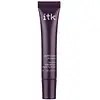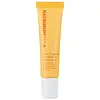What's inside
What's inside
 Key Ingredients
Key Ingredients

 Benefits
Benefits

 Concerns
Concerns

 Ingredients Side-by-side
Ingredients Side-by-side

Polybutene
Hydrogenated Polyisobutene
EmollientDiisostearyl Malate
EmollientMicrocrystalline Wax
Emulsion StabilisingSynthetic Wax
AbrasivePolyglyceryl-2 Triisostearate
EmulsifyingHydrogenated Styrene/Isoprene Copolymer
Triacontanyl Pvp
HumectantButyrospermum Parkii Butter
Skin ConditioningTheobroma Cacao Seed Butter
EmollientEuphorbia Cerifera Wax
Cocos Nucifera Oil
MaskingCopernicia Cerifera Wax
Glyceryl Caprylate
EmollientTocopheryl Acetate
AntioxidantPolybutene, Hydrogenated Polyisobutene, Diisostearyl Malate, Microcrystalline Wax, Synthetic Wax, Polyglyceryl-2 Triisostearate, Hydrogenated Styrene/Isoprene Copolymer, Triacontanyl Pvp, Butyrospermum Parkii Butter, Theobroma Cacao Seed Butter, Euphorbia Cerifera Wax, Cocos Nucifera Oil, Copernicia Cerifera Wax, Glyceryl Caprylate, Tocopheryl Acetate
Polybutene
Hydrogenated Polydecene
EmollientBis-Diglyceryl Polyacyladipate-2
EmollientHydrogenated Styrene/Isoprene Copolymer
Cera Microcristallina
Emulsion StabilisingSilica
AbrasiveRubus Chamaemorus Seed Oil
Skin ConditioningGarcinia Indica Seed Butter
Skin ConditioningEuterpe Oleracea Sterols
Skin ConditioningPalmitoyl Hexapeptide-12
Skin ConditioningPalmitoyl Tripeptide-1
Skin ConditioningTocopheryl Acetate
AntioxidantTocopherol
AntioxidantIrvingia Gabonensis Kernel Butter
Skin ConditioningCitrus Aurantium Dulcis Fruit Extract
MaskingLinoleic Acid
CleansingLinolenic Acid
CleansingOleic Acid
EmollientLactic Acid
BufferingHelianthus Annuus Seed Oil
EmollientCaprylic/Capric Triglyceride
MaskingCopernicia Cerifera Wax
Hydrogenated Coco-Glycerides
EmollientSorbitan Isostearate
EmulsifyingPentaerythrityl Tetraisostearate
EmollientPentaerythrityl Tetra-Di-T-Butyl Hydroxyhydrocinnamate
AntioxidantOctyldodecanol
EmollientEthylhexyl Palmitate
EmollientDicalcium Phosphate
AbrasiveTribehenin
EmollientPropylene Carbonate
SolventStearalkonium Hectorite
Gel FormingParfum
MaskingCitral
PerfumingLimonene
PerfumingLinalool
PerfumingIron Oxides
CI 77891
Cosmetic ColorantPolybutene, Hydrogenated Polydecene, Bis-Diglyceryl Polyacyladipate-2, Hydrogenated Styrene/Isoprene Copolymer, Cera Microcristallina, Silica, Rubus Chamaemorus Seed Oil, Garcinia Indica Seed Butter, Euterpe Oleracea Sterols, Palmitoyl Hexapeptide-12, Palmitoyl Tripeptide-1, Tocopheryl Acetate, Tocopherol, Irvingia Gabonensis Kernel Butter, Citrus Aurantium Dulcis Fruit Extract, Linoleic Acid, Linolenic Acid, Oleic Acid, Lactic Acid, Helianthus Annuus Seed Oil, Caprylic/Capric Triglyceride, Copernicia Cerifera Wax, Hydrogenated Coco-Glycerides, Sorbitan Isostearate, Pentaerythrityl Tetraisostearate, Pentaerythrityl Tetra-Di-T-Butyl Hydroxyhydrocinnamate, Octyldodecanol, Ethylhexyl Palmitate, Dicalcium Phosphate, Tribehenin, Propylene Carbonate, Stearalkonium Hectorite, Parfum, Citral, Limonene, Linalool, Iron Oxides, CI 77891
 Reviews
Reviews

Ingredients Explained
These ingredients are found in both products.
Ingredients higher up in an ingredient list are typically present in a larger amount.
Copernicia Cerifera Wax comes from a palm tree native to Brazil; another name for this ingredient is Carnauba Wax.
This ingredient is used to thicken texture and also leaves behind a film when applied.
Fun fact: This wax has the highest melting point of all natural waxes and low solubility.
Learn more about Copernicia Cerifera WaxWe don't have a description for Hydrogenated Styrene/Isoprene Copolymer yet.
Polybutene is used to help control the viscosity of a product. This just means it helps adjusts the texture.
It is a polymer and does not get absorbed into the skin due to its large size.
Studies found this ingredient did not irritate skin in concentrations below 15%.
Learn more about PolybuteneTocopheryl Acetate is AKA Vitamin E. It is an antioxidant and protects your skin from free radicals. Free radicals damage the skin by breaking down collagen.
One study found using Tocopheryl Acetate with Vitamin C decreased the number of sunburned cells.
Tocopheryl Acetate is commonly found in both skincare and dietary supplements.
Learn more about Tocopheryl Acetate